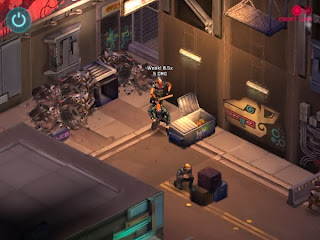 Review by Matt S.
Review by Matt S.
Shadowrun is a legendary RPG, both in terms of the pen-and-paper tabletop game and the original console release a few generations ago. When a certain big publisher decided that the ‘reboot’ of Shadowrun would be yet another generic FPS and managed to annoy the long time fans, a little indie developer decided to run a Kickstarter to produce a ‘true’ new Shadowrun game.
Shadowrun Returns is that game. It’s been on PC for a while (you can read our review here), but the iPad version is perhaps a better fit. It’s a fairly small game by RPG standards and well suited to half hour play sessions. At the same time, it’s a deep enough narrative that it can be a compelling game to settle down in bed with after a long play session.
Creating a ripper murder mystery narrative within Shadowrun’s Cyberpunk setting is a masterstroke. Playing the role of investigator you’re going to be exploring some of the most deplorable environments imaginable in order to solve the case and you’ll come across the very worst that humanity has to offer. It’s a setup that is ripe for exotic locations and intense battles, and Shadowrun takes full advantage of that potential. Because the production values in the game are limited – we’re talking static top-down isomentric environments and a complete absence of voice acting and the like – Shadowrun Returns has that delightful retro feel to it, whereby players are asked to use their imagination rather than rely on having everything dictated to them as with modern games. Those who can stretch the imagination will find a narrative that is endlessly rewarding.

Combat is a little reminiscent of XCOM, and that is hardly a bad thing. Players get a certain number of actions per turn, and can take cover, reload weapons, shoot at distant enemies, cast magic and so on in a turn-based fashion. My favourite trick is to specialise in melee and use weapons that knock down an enemy’s actions. Those attacks might not do much damage, but immobalising the enemy allows me to control the battlefield and prevent counter attacks. Other players will find their own strategies and this is a mark of a great turn based combat system, but I do have one major complaint and it’s a big one – somehow magic users get to attack through the terrain, and so cover is largely useless against them. It removes the sense of reward in cleverly positioning your heroes.

I can tolerate FPSers treating players like idiots who would get lost if they had the option of two paths through a level, or ran into a dead end. But RPGs need to treat their players with more respect than that. Exploration is a core requirement of a good RPG, and Shadowrun Returns fails at this. Final Fantasy XIII was less linear.

It’s also worth mentioning that the iPad version of Shadowrun is half the price of the PC game, but comes with half the content too; where the PC game has a full-fledged scenario creator and sharing tool, the iPad game doesn’t give players access to any of that content. That means no playing the player-created scenarios, and no creating your own. This is disappointing considering that Disney Infinity Toy Box has already shown us that not only are these features possible on iOS, but they’re fun. For people that do finish the default scenario in Shadowrun, you’ll need to wait until January next year for the next “official” scenario.
These criticisms aside, Shadowrun Returns is a nice, brief (at about 15 hours) RPG narrative. It’s too passive for its own good, but the setting and quality of the writing make it worthwhile for fans of the original, or the Cyberpunk genre in general. Just be aware that the iPad is not exactly short on must-play RPGs now, and Shadowrun doesn’t come close to the standards of the likes of Avernum, Baldur’s Gate or Knight of the Old Republic.
And hey, it’s better than the abysmal Shadowrun FPS.
– Matt S
Editor-in-Chief
Find me on Twitter: @DigitallyDownld
Our Scoring Policy







